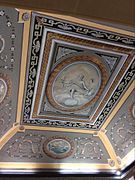Palazzo Parisio (Valletta)
| Palazzo Parisio | |
|---|---|
Ministry for Foreign Affairs | |
| Named for | Paolo Parisio Muscati |
| Construction started | c. 1740 |
| Completed | 1744 |
| Owner | Government of Malta |
| Technical details | |
| Material | Limestone |
| Floor count | 3 |
| Design and construction | |
| Architect(s) | Peruzzi[clarification needed] |
| Website | |
| Ministry for Foreign Affairs | |
Palazzo Parisio, sometimes known as Casa Parisio,
Location
Palazzo Parisio is on Merchants Street, originally called Strada San Giacomo, one of the main streets in Valletta.[3] The palace is adjacent to Auberge de Castille, which is now the office of the Prime Minister. It faces Auberge d'Italie, which houses Muza, the National museum of art.[4]
History
Construction and early history
The site of Palazzo Parisio originally contained two town houses, which belonged to Fra Michel Fonterme dit la Chiesa and Francesco This. The houses were purchased by Fra Giovanni di Ventimiglia, the Balì of Manosca, in 1608.[3] His descendants exchanged the houses with Maria Sceberras in 1717.[5]
In about 1740, Domenico Sceberras demolished the town houses and began to build the palace. It was completed in 1744 by Margherita Muscati, his sister, and remained in the hands of the Muscati family. Eventually, it was inherited by Anna Muscati, who married Domenico Parisio.[6] By the late 18th century, the palace belonged to Paolo Parisio Muscati, who named the building Palazzo Parisio.[7]
French occupation

After the French invasion of Malta, Napoleon stayed at Palazzo Parisio for six days from 12 to 18 June 1798, before embarking on the Egyptian campaign. Following the Maltese uprising against French rule, Parisio Muscati left Valletta to join the Maltese insurgents, where he commanded the Naxxar battalion.[7]
Nineteenth century

After Malta became a
Following Parisio Muscati's death in December 1841, the palace was passed to his wife Antonia Muscati Xara. She married Joseph de Piro and the palace passed into the hands of the de Piro family after she died in 1856.[8] The de Piro family had eventually came to an agreement with the British government to exchange the palace with Casa Caccia.[9]
General Post Office
By the 1880s, Palazzo Parisio was co-owned by around 100 people, and was in poor condition. In 1886 the postmaster-general, Ferdinand Inglott, persuaded the owners to lease, and eventually to sell, the palace to the government. It was renovated, and opened as the General Post Office (GPO) in May 1886.[8] The ground floor was used as a livery yard for horses to be used by postmen.[10]
A third floor which housed the Audit Office was added after World War I.[8] The building was included on the Antiquities List of 1925.[11]
On 24 April 1942, during
On 4 July 1973, the GPO moved from Palazzo Parisio to Auberge d'Italie, just across the street. The central mail room, registered letter branch and poste restante were moved to the former Garrison Chapel, which is now occupied by the Malta Stock Exchange.[14]
Ministry for Foreign Affairs
The first ministry that the building served was the Ministry for Posts and Agriculture.
The palace is scheduled as a Grade 1 national monument by the Malta Environment and Planning Authority.[5] It is also listed on the National Inventory of the Cultural Property of the Maltese Islands.[6]
Architecture
Palazzo Parisio was designed by the architect Peruzzi,[19] and it contains elements from both neoclassical[20] and baroque architecture.[21]
The palace consists of three blocks, which surround a central courtyard. The façade contains an elaborate columned doorway, supporting a timber balcony. There are three windows on either side of the doorway.[6]
-
Palazzo Parisio from Merchants Street
-
Side façade along Melita Street
-
Doorway and balcony
-
Plaque commemorating Napoleon's stay[22]
-
Courtyard
-
Rustic interior
-
Hallway
-
Pardo Hall
-
Pardo Hall
-
Pardo Hall
-
Entry to Sala Giorgio Borg Olivier
-
George Borg Olivier Hall
-
First floor
-
Second floor
-
Napoleon's bedroom
-
Cabinet where visiting dignitaries sign
-
Stairs
-
Decorated wooden ceiling beams
-
Frescoes lost in World War II
-
Underground stairs
-
Chapel[23]
Art
The ceilings and walls of the palace have a number of frescoes painted by the Maltese artist Antonaci Grech. Some were destroyed when the palace was bombed in World War II, but others remain in good condition.[24]
A number of paintings are found in the palace; those by the Italian artist Mattia Preti are older than the palace itself.[25]
-
Supper at Emmaus, a c. 1680 painting by Mattia Preti
-
Ceiling fresco
-
Ceiling fresco
-
Wall and ceiling frescoes
-
Traditional Maltese clock and cabinet
-
Restored 18th century statue
-
Artworks and furniture at Giorgio Borg Olivier Hall
-
Painting and antique Chinese cabinet
-
Neapolitan handmade crib
-
Bust of Jean de Valette
Further reading
- Denaro Victor F., "The Story of Palazzo Parisio", pp. 78–84.
- Denaro Victor F., "Houses in Merchant Street, Valletta", pp. 158, 159.
- Guillaumier, Alfie (2005). Bliet u Rħula Maltin (in Maltese). ISBN 99932-39-40-2.
- Antonia Moscati Gatto Xara
See also
Notes
- ^ "Palazzo" (pl. palazzi): is any large building property of the state or private (often much smaller than the term palace implies in the English-speaking world). While palazzo is the technically correct appellation, and postal address, no aristocrat would ever use the word, instead referring to his or her own house, however large, as "casa". "Palazzo" followed by the family name was the term used by officials, tradesmen, and delivery men. During the rule of the Order it was known as Casa Parisio/Parisi or Casa del Barone Parisio/Parisi.[2]
References
- ^ "Rivista" (in Italian). 30. Presso il Collegio araldico. 1931: 470.
{{cite journal}}: Cite journal requires|journal=(help) - ^ "Grazio V. Ellul. The French Invasion of Malta. Hyphen. p. 15" (PDF). Archived from the original (PDF) on 29 March 2017. Retrieved 27 August 2017.
- ^ a b c Denaro, Victor F. (1958). "Houses in Merchants Street, Valletta" (PDF). Melita Historica. 2 (3): 158–159.
- ISBN 9781849656481.
- ^ a b "One World - Palazzo Parisio". Times of Malta. 15 July 2008. Retrieved 15 September 2015.
- ^ a b c "Palazzo Parisio" (PDF). National Inventory of the Cultural Property of the Maltese Islands. 28 December 2012. Retrieved 15 September 2015.
- ^ a b c d "Palazzo Parisio". Ministry for Foreign Affairs. Retrieved 22 March 2020.
- ^ a b c "Villa Parisio and the Strickland Foundation". user.orbit.net.mt. Archived from the original on 4 March 2016. Retrieved 15 September 2015.
- ^ Denaro, Victor F. (1959). Houses in Kingsway and Old Bakery Street, Valletta Archived 17 November 2015 at the Wayback Machine. Melita historica. Journal of the Malta Historical Society. 2 (4). p. 204.
- ^ Traill, Henry Duff (1891). "The Picturesque Mediterranean" (PDF). 2. from University of California: Cassell: 49.
{{cite journal}}: Cite journal requires|journal=(help) - ^ "Protection of Antiquities Regulations 21st November, 1932 Government Notice 402 of 1932, as Amended by Government Notices 127 of 1935 and 338 of 1939". Malta Environment and Planning Authority. Archived from the original on 19 April 2016.
- ^ "The Maltese Postal Service – A Short Historical Sketch". The Malta Independent. 22 August 2010. Retrieved 15 September 2015.
- ISBN 1872465315.
- ^ "Maltapost privatisation latest red-letter day in postal history". Times of Malta. 21 January 2008. Retrieved 15 September 2015.
- ^ Owen's African and Middle East Commerce & Travel and International Register. p. 885.
- ^ "Inħarsu lejn il-Belt Valletta minn erba' aspetti differenti". Department of Information (in Maltese). 1 August 2003. Retrieved 15 September 2015.
- ^ Zammit, Rosanne (3 March 2003). "The capital starting to light up, as the restorers do their work". Times of Malta. Retrieved 15 September 2015.
- ^ Kundizzjonijiet tal-mistħija fil-Ministeru tal-Affarijiet Barranin f’Palazzo Parisio. Net News. 24 September 2014. Retrieved on 18 July 2016.
- ^ Frendo, Henry (1989). Malta's Quest for Independence: Reflections on the Course of Maltese History. Valletta: Valletta Publishing & Promotion Co. Ltd. p. 52.
- ^ "Palazzo Parisio". myGuide. Retrieved 15 September 2015.
- ^ De Lucca, Denis (December 2013). "The city-fortress of Valletta in the Baroque age" (PDF). Baroque Routes (9): 16.
- ISBN 99932-39-40-2.
- ^ "Valletta". www.malta-canada.com. Archived from the original on 20 February 2010. Retrieved 30 June 2022.
- ^ "Palazzo Parisio". Ministry for Foreign Affairs (in Maltese). Retrieved 15 September 2015.
- ISBN 9789993272496.


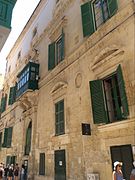

![Plaque commemorating Napoleon's stay[22]](http://upload.wikimedia.org/wikipedia/commons/thumb/f/f8/Plaque_Napol%C3%A9on_%C3%A0_La_Valette.JPG/431px-Plaque_Napol%C3%A9on_%C3%A0_La_Valette.JPG)


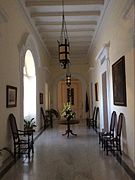









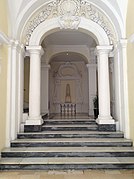


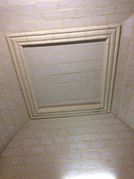

![Chapel[23]](http://upload.wikimedia.org/wikipedia/commons/thumb/8/83/Chapel_at_Palazzo_Parisio.jpg/135px-Chapel_at_Palazzo_Parisio.jpg)


